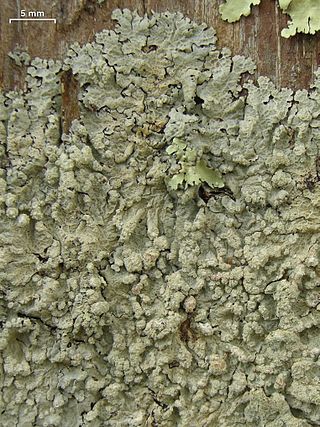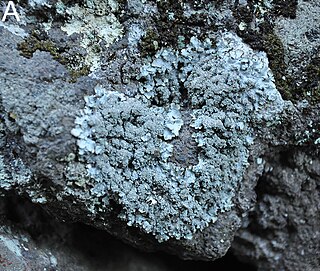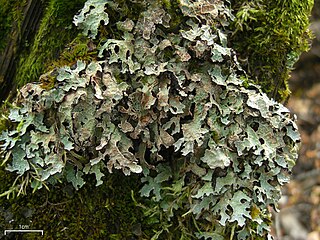
Parmelia is a genus of medium to large foliose lichens. It has a global distribution, extending from the Arctic to the Antarctic continent but concentrated in temperate regions. There are about 40 species in Parmelia. In recent decades, the once large genus Parmelia has been divided into a number of smaller genera according to thallus morphology and phylogenetic relatedness.

Melanelixia is a genus of foliose lichens in the family Parmeliaceae. It contains 15 Northern Hemisphere species that grow on bark or on wood. The genus is characterized by a pored or fenestrate epicortex, and the production of lecanoric acid as the primary chemical constituent of the medulla. Melanelixia was circumscribed in 2004 as a segregate of the related genus Melanelia.

Esslingeriana is a fungal genus in the family Parmeliaceae. The genus is monotypic, containing the single foliose lichen species Esslingeriana idahoensis, commonly known as the tinted rag lichen. It is found in northwestern North America.
Relicina colombiana is a species of saxicolous (rock-dwelling), foliose lichen in the family Parmeliaceae. Found in high-elevation páramo of the Eastern Cordillera in Colombia, it was described as new to science in 2011.
Parmelia asiatica is a species of corticolous (bark-dwelling) foliose lichen in the family Parmeliaceae. It occurs in China and the Russian Far East, where it grows on Rhododendron tree trunks in temperate regions. It was Described as new to science in 2011 by lichenologists Ana Crespo and Pradeep Divakar. The species is distinguished by its terminal soralia, marginal linear pseudocyphellae, and chemical composition, which includes the substances atranorin and salazinic acid. Parmelia asiatica is similar to Parmelia protosulcata but differs in the presence of salazinic acid and its distribution in Southeast Asia.
Parmotrema albinatum is a species of foliose lichen in the family Parmeliaceae that is found in Hawaii. It was originally described in 2001 as Rimelia albinata. Later phylogenetic analysis demonstrated that the genus Rimelia was synonymous with Parmotrema, so this species was transferred to that genus. The lichen is characterized by the sorediate and short-lacinulate thallus with salazinic acid in the medulla and traces of lobaric acid. The upper surface of the thallus is whitish, which probably a result of the thickness of the thick upper cortex.

Crespoa is a genus of five species of lichen in the family Parmeliaceae. Species in this genus are characterized by having an upper thallus surface that is wrinkled and reticulately ridged to coarsely foveolate.
Remototrachyna is a genus of foliose lichens in the large family Parmeliaceae. It was separated from the genus Hypotrachyna based on the structure of the excipulum and genetic differences.
Emodomelanelia is a lichen genus in the family Parmeliaceae. It is monotypic, containing the single foliose Himalayan species Emodomelanelia masonii.
Austromelanelixia is a genus of five species of foliose lichens in the family Parmeliaceae. All species are found in the Southern Hemisphere.
Hypotrachyna vainioi is a species of foliose lichen in the family Parmeliaceae. It is found in Brazil.

Punctelia guanchica is a species of foliose lichen in the family Parmeliaceae that is only known from the Canary Islands. It is similar in appearance and morphology to the North American Punctelia rudecta, and was historically misidentified as that species until molecular phylogenetic evidence showed it to be a distinct species. It differs in having thicker isidia that develop from the centre of the pseudocyphellae, and it mainly grows on rocks.

Punctelia reddenda is a widely distributed species of foliose lichen in the family Parmeliaceae. It occurs in Africa, Europe, North America, and South America, where it grows on bark and on rock.

Parmelia barrenoae is a species of foliose lichen in the large family Parmeliaceae. It was formally described as a new species in 2005. Before this, it was lumped together as one of several lichens in the Parmelia sulcata group—a species complex of genetically distinct lookalikes. Parmelia barrenoae is widely distributed, occurring in Europe, western North America, Africa, and Asia.

Parmelia fraudans is a species of foliose lichen in the family Parmeliaceae. It is found in Europe and North America, where it grows on rocks.
Xanthoparmelia isidiovagans is a species of foliose lichen in the family Parmeliaceae
Remototrachyna sipmaniana is a species of saxicolous (rock-dwelling), foliose lichen in the family Parmeliaceae. It is only known to occur in Bolivia, where it grows on boulders in Yungas mountain cloud forests.
Flavoparmelia virensica is a species of corticolous (bark-dwelling), foliose lichen found in Western Australia, newly described in 2010. This species, belonging to the large family Parmeliaceae, is similar in appearance to Flavoparmelia rutidota and F. caperatula, but can be distinguished by its spindle-shaped conidia and significant quantities of virensic acid. The lichen grows on dead and burnt wood as well as the bark of trees from the genera Allocasuarina, Acacia, and Hakea.
Xanthoparmelia nomosa is a species of saxicolous (rock-dwelling), foliose lichen in the family Parmeliaceae. It is found in Tasmania, Australia.
Xanthoparmelia somervilleae is a species of saxicolous (rock-dwelling), foliose lichen in the family Parmeliaceae. It is found in Tasmania, Australia.







